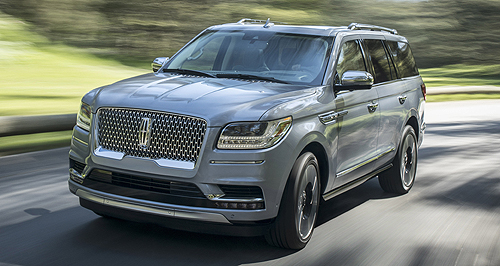Future models - Lincoln - NavigatorNew York show: Lincoln reinvents the NavigatorTouchpoint: Lincoln’s designers have aimed to emphasise “ultra-luxury touchpoints” on the new Navigator, so that everything people see and touch seems like it is a cut above the rest. Aussie fingerprints on all-new Lincoln Navigator as Ford ramps up SUV assault in US13 Apr 2017 By TERRY MARTIN FORD Motor Company presented its long-anticipated new-generation Lincoln Navigator at the New York auto show overnight, bearing some Australian fingerprints with what is the first redesign for the full-size luxury SUV in a decade. The Navigator was one of the pioneering models in this segment, but market share and sales have eroded as competition intensified in North America with models such as the Cadillac Escalade and Infiniti QX80. It is based on the same platform and shares components and features with Ford’s new Expedition unveiled in Dallas, Texas, in February, albeit with luxury fittings and design elements befitting its status as a Lincoln model. GoAuto understands the new Navigator was primarily developed in North America, but the Australian-based Asia-Pacific Product Development Centre is likely to have had input into the program given its status as a key R&D hub for Ford Motor Company vehicles worldwide. Asked about the Australian design and engineering team’s level of involvement in the Navigator program, Ford Australia product communications manager Damion Smy would only say that “our local team works as part of an integrated global group, with Australia hosting the Asia-Pacific Product Development Centre that’s a crucial global development hub”. As previously reported, Ford’s Australian operations have been recently spotted testing Range Rovers at its You Yangs proving ground near Lara, south-west of Melbourne, as Ford moves full-steam ahead with SUV development and prepares to launch several all-new models before 2020 – including the new Navigator, another still-secret Lincoln SUV for China, the all-new Ford Bronco and related new-generation Everest. Lincoln’s former head of exterior design and one-time overall design chief, Max Wolff, would have also been involved in the Navigator program before returning home to Australia from Detroit at the end of 2015 to begin work on new programs at the Asia-Pacific centre, leaving Earl Lucas in charge of exterior design for the big new SUV – under the watch of Lincoln design director David Woodhouse. The team has kept the design of the concept unveiled at the New York show last year largely intact with the transition to production, although items such as gullwing doors have disappeared and detail changes to the grille and headlights are apparent. Ford engineers saved about 90kg through the use of (high-strength) aluminium across the body, boosting refinement in the process, while additional weight savings were “reinvested” in areas such as towing capability (still to be specified) and additional noise-reduction measures including laminated front and side glass. Power comes from a new twin-turbocharged 3.5-litre V6 petrol engine “projected to produce 450 horsepower” (335kW), driving through a 10-speed automatic transmission. Fuel economy is said to have improved, but specific details are still to be announced. The level of advanced technology on-board has gone up a notch with speed-dependent adaptive front lighting, a 360-degree camera with enhanced park assist, adaptive cruise control, a trailer backup assist system (which automatically steers the vehicle to turn a trailer the desired amount), head-up display, wireless phone charging up front and standard Wi-Fi allowing for up to 10 mobile devices at a time to be connected. Driver the front passenger seats offer 30-way adjustment and include massage, heating and cooling functionality, while the “personal profile” linked to the key fob can recall driver seat, mirror and pedal position preferences, along with climate control and audio settings. There are six USB ports, four 12-volt power outlets and a 110-volt plug on-board the new Navigator, along with individual audio and climate controls for second-row passengers and a power-recline function for the third-row seats. An optional rear-seat entertainment system enables content to be streamed wirelessly with an Android device to one of the 10-inch adjustable screens mounted on the rear of the front seats, or else accessed via other devices like an SD card, HDMI cord, USB or AppLink (via the Sync3 infotainment system). The luggage area includes an “advanced cargo management system” that includes an adjustable shelf behind the rear seats designed to keep items of various shapes and sizes well secured. “When designing the Navigator, we put an emphasis on ultra-luxury touch points,” Mr Woodhouse said. “We took everything the client would see and touch, and made sure it would look and feel a little more exuberant, a little more indulgent and incredibly beautiful.”  Read more21st of March 2017  Exclusive: Ford benchmarks Range RoverLuxury Range Rover in secret tests as Ford gets ready for five new SUVs17th of November 2015  Designer Wolff headed homeSenior Lincoln designer Max Wolff heading to Ford Australia on a mystery mission31st of March 2015  New York show: Lincoln resurrects ContinentalLincoln Continental concept breaks cover, will be the brand’s next flagship24th of July 2014  Top global role for Aussie-based Ford engineerAustralia a key link as latest top Ford appointments focus on engineering, Lincoln |
Click to shareMotor industry news |































Facebook Twitter Instagram